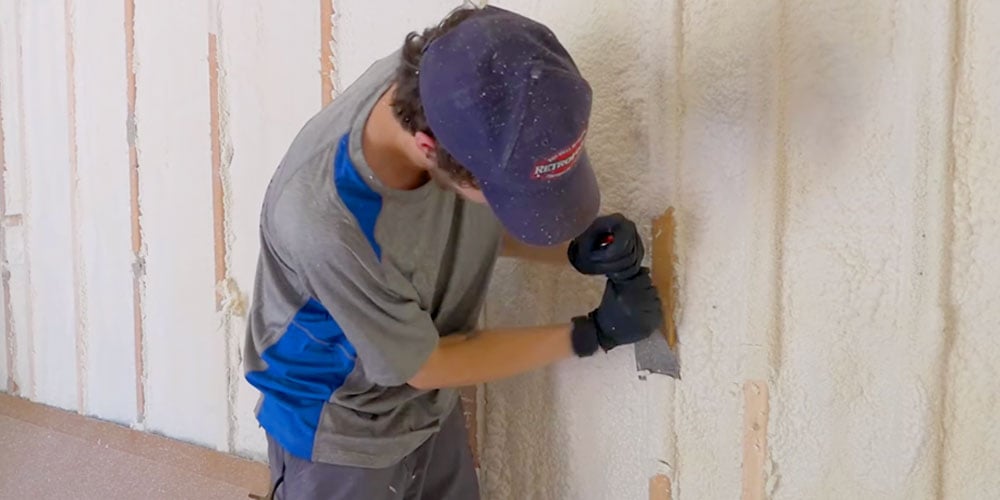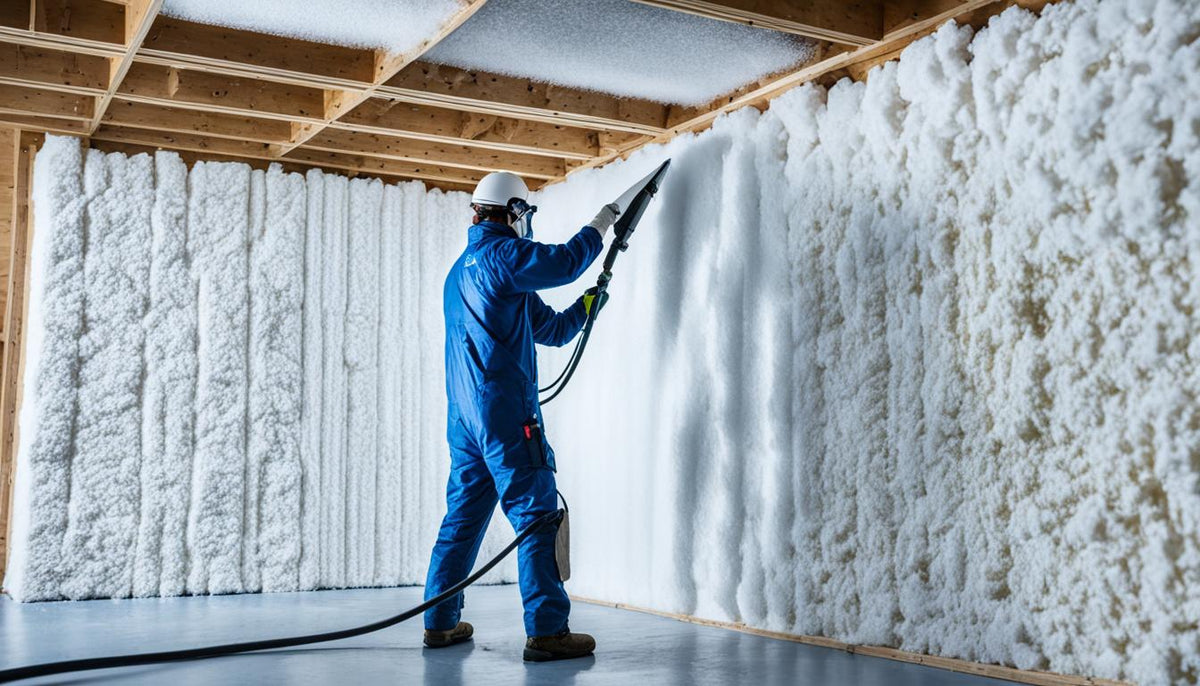Spray Foam: The Ultimate Remedy for Air Sealing and Insulation
Spray foam insulation has emerged as a leading service for efficient air securing and thermal insulation, supplying an unique mix of residential or commercial properties that establish it apart from typical techniques. Understanding the full scope of its advantages, setup processes, and comparisons with other insulation kinds is critical for making educated choices.
What Is Spray Foam?
Spray foam is a functional insulation product that combines the principles of air sealing and thermal resistance to enhance power performance in buildings. Made up largely of polyurethane or other comparable compounds, spray foam is used as a liquid that broadens upon contact with surface areas, producing a strong, continuous layer of insulation. This special home permits it to fill gaps, splits, and voids that typical insulation materials might forget, offering a remarkable air seal.
There are 2 primary kinds of spray foam: open-cell and closed-cell. Open-cell spray foam is lighter and much more flexible, offering excellent noise absorption and a lower R-value per inch - Spray Foam. On the other hand, closed-cell spray foam is denser, supplying a higher R-value, dampness resistance, and added architectural stability to building components
The application process typically involves specific equipment, guaranteeing a smooth application that complies with different substrates, including timber, concrete, and metal. This versatility makes spray foam ideal for both brand-new buildings and retrofitting existing frameworks. Its ability to produce an airtight obstacle dramatically adds to decreasing power intake and boosting interior air quality, thus making it a recommended option amongst home owners and contractors alike.
Benefits of Spray Foam Insulation
Among the most considerable benefits of spray foam insulation is its remarkable capacity to create a continual air obstacle, which effectively decreases power loss. Unlike typical insulation products, spray foam broadens to fill up fractures and gaps, making certain that air leak is dramatically decreased. This particular not just enhances energy effectiveness however also leads to reduce energy costs gradually.
Additionally, spray foam insulation offers premium thermal resistance, adding to a much more steady indoor setting. Its high R-value per inch permits reliable insulation in constrained rooms, making it excellent for attics, walls, and crawl rooms. The moisture-resistant residential properties of spray foam aid protect against mold and mildew development, promoting much healthier living problems.
An additional important benefit of spray foam insulation is its sound-dampening top qualities (Spray Foam). It successfully minimizes noise transmission between spaces, producing a quieter and extra comfy home setting. The longevity of spray foam additionally sticks out, as it does not droop or work out gradually, keeping its efficiency throughout its lifespan
Just How Spray Foam Functions
Recognizing just how spray foam insulation works is necessary for valuing its performance in air securing and thermal resistance. Spray foam insulation consists of 2 main parts: isocyanate and polyol resin. When these components are mixed, they go through a chemical response that creates the material to broaden quickly, creating a thick foam that fills up gaps, dental caries, and go to this site splits.
As the foam expands, it follows surfaces, creating an impermeable seal that substantially lowers air infiltration. This particular makes spray foam insulation very efficient at avoiding drafts image source and wetness infiltration, which can bring about power loss and damages gradually. In addition, the closed-cell version of spray foam provides premium thermal resistance due to its stiff framework, successfully minimizing warmth transfer.
The one-of-a-kind residential or commercial properties of spray foam permit it to comply with irregular surfaces, making sure detailed coverage and a seamless obstacle. Because of this, spray foam insulation not only boosts power performance but likewise adds to enhanced indoor air quality by minimizing the accumulation of allergens and contaminants. Ultimately, recognizing the mechanics behind spray foam underscores its duty as an exceptional choice for insulation and air sealing in both domestic and business applications.
Setup Process Overview

Before installation, the space needs to be sufficiently cleaned and prepped, ensuring that surfaces are devoid of dampness, dust, and debris. This step is essential because pollutants can jeopardize bond and general performance. Once the area is prepared, the application involves blending the 2 parts of the spray foam, which increases upon contact and loads gaps effectively.
Trained professionals should conduct the installation, using specific equipment to make certain uniform insurance coverage and optimal thickness. Safety precautions, including wearing discover this info here protective gear and ensuring proper ventilation, are imperative throughout this process. After application, the foam generally cures promptly, developing a strong barrier that boosts energy effectiveness.
Contrasting Spray Foam to Traditional Insulation
When examining insulation options, spray foam insulation stands apart in contrast to standard materials such as fiberglass and cellulose. One of the key benefits of spray foam is its exceptional air securing capacities. Unlike fiberglass and cellulose, which can enable air infiltration, spray foam increases upon application, filling up holes and gaps to develop a closed seal. This causes improved energy performance, as less warmed or cooled down air runs away the home, resulting in reduced utility expenses.
Furthermore, spray foam provides a greater R-value per inch than traditional insulation kinds, offering more reliable thermal resistance in a thinner account. This characteristic is especially valuable in spaces with limited tooth cavity depth. Moreover, spray foam is immune to moisture and mold and mildew growth, which can be a considerable issue with cellulose and fiberglass, particularly in moist settings.
However, spray foam insulation usually carries a higher upfront expense than its conventional equivalents. House owners have to consider this preliminary financial investment against lasting energy financial savings and efficiency benefits. Ultimately, while both insulation kinds offer their objective, spray foam emerges as a much more innovative solution for modern insulation needs, specifically in terms of air securing and thermal efficiency.

Verdict
In summary, spray foam insulation represents a highly effective solution for accomplishing optimal air sealing and thermal resistance. Its unique residential properties, including moisture resistance and noise dampening, make it appropriate for different applications in both new buildings and retrofitting projects (Spray Foam). The initial prices might be greater compared to traditional insulation materials, the lasting benefits, such as substantial energy financial savings and improved indoor air high quality, validate the investment and underscore its worth in modern-day structure methods.
Spray foam insulation has actually arised as a leading service for reliable air sealing and thermal insulation, offering a special mix of residential properties that set it apart from typical techniques.Spray foam is a versatile insulation material that combines the concepts of air securing and thermal resistance to enhance power efficiency in structures.When reviewing insulation choices, spray foam insulation stands out in contrast to standard materials such as fiberglass and cellulose. Eventually, while both insulation types serve their function, spray foam arises as an extra sophisticated option for contemporary insulation requirements, especially in terms of air sealing and thermal performance.
In summary, spray foam insulation represents a very reliable service for accomplishing ideal air securing and thermal resistance.